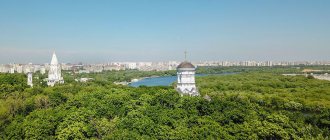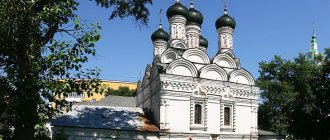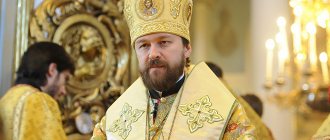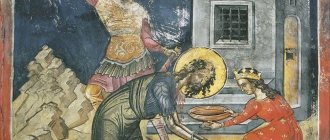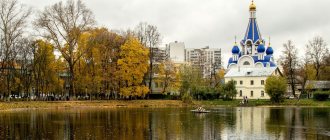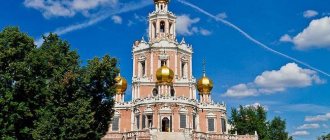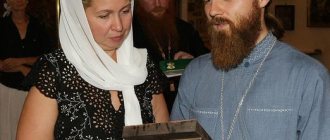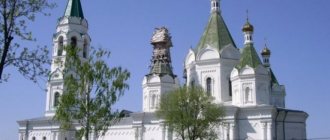| Moscow.Church of the Beheading of John the Baptist near Bor |
Moscow Church in honor of the Beheading of St.
Prophet John the Baptist near Bor , the patriarchal metochion of the Russian Orthodox Church, a temple assigned to the St. Michael-Feodorovskaya Church
- Thrones: Beheadings of John the Baptist, Nicholas the Wonderworker, Cosmas and Damian
- Address: Russia, Moscow, Pyatnitskaya st., 4/2, building 9
- Directions: metro station "Novokuznetskaya"
- Official site:
- On the map: Yandex.Map, Google map
In 1514, in Ioannovsky “under the forest” monastery, on behalf of Grand Duke Vasily III, the Italian architect Aleviz Fryazin (“New”) erected a stone church of the Beheading of John the Baptist on the site of a dilapidated wooden monastery church, consecrated on August 29, 1515.
This was probably the first stone temple in Zarechye. In 1578, at the walls of the Church of John the Baptist, the Tsar, the Metropolitan and ordinary believers solemnly greeted the holy relics of Prince Mikhail of Chernigov and his faithful boyar Theodore, transferred from Chernigov. In memory of this meeting, a wooden temple was built in the name of the Chernigov miracle workers, the first mention of which dates back to 1625. In 1675, a stone five-domed single-altar church of the martyrs Michael and Theodore arose in its place, which has survived to this day.
The Church of the Beheading of John the Baptist was destroyed in 1612 at the height of the Time of Troubles. In 1658 it was rebuilt again. White stone fragments from the Aleviz building have been preserved in the foundations and basement of the currently existing temple. Therefore, 1658 is usually considered the year the temple was built. A stone bell tower was erected near the western wall, but was soon dismantled due to damage.
In the 18th century, the main volume of the temple was altered - its completion was changed. Therefore, you can see a mixture of styles in it: the design of the walls corresponds to the ancient Russian architecture of the 17th century (windows with stacked columns and kokoshniks, runner, curb), and the completion of the temple (semi-domes, octagonal drum) is typical of Russian Baroque.
In 1758-60. a refectory was built (also baroque). In 1780 or 1781, after the old bell tower was dismantled, a new, separate one was built. It already shows the features of the transition from Baroque to Classicism.
At the end of the 19th century, a western porch was added, and at the beginning of the century, a porch with a porch was added.
The temple was renovated in 1796, in 1896-1904. (F.O. Shekhtel took part in these works).
In 1917, the churches of the Chernigov metochion were closed. They were occupied by various organizations.
In 1977, on the eve of the 1980 Olympic Games, both churches with a bell tower underwent partial restoration. Domes and crosses reappeared, and fragments of paintings from the 17th and 19th centuries were discovered in the interiors. The fence with a lattice was restored, the domes were covered with emerald tiles.
By the beginning of the 1990s. The building housed the exhibition hall of the GIS “Art Glass”.
In the early 1990s, the temple was returned to believers.
In 1997, services were resumed in the Church of John the Baptist near Bor.
On November 1, 2015, Patriarch Kirill of Moscow and All Rus' performed the rite of great consecration of the temple.
It has the status of a Patriarchal Metochion along with the neighboring Church of Michael and Fyodor, Chernigov Wonderworkers, to which it is affiliated.
Church of the Beheading of John the Baptist
Share
Source: ru.wikipedia.org Photo author: Ludvig14
The history of the Church of the Beheading of John the Baptist dates back to 1515. Then, on the site of the wooden monastery church (and in these places there was the Ivanovo Monastery, which was later moved to another place), the architect Aleviz Novy, by the way, one of the builders of the Kremlin, erected a white stone church and erected a hipped bell tower nearby.
However, a little over forty years later, in 1658, in the same place, on the stone basement of the church of Aleviz the New, a new church building was erected. Frankly speaking, I was unable to find the reasons for such a rapid demolition of the stone church, which was barely forty years old. Although, presumably, they were and were quite significant.
Be that as it may, a new church was erected with elements of the baroque that was becoming fashionable and a design characteristic of that time - an octagon on a quadrangle. That is, an octahedron on a tetrahedron. The temple building is topped with an onion dome on a narrow drum.
Interestingly, during restoration work in the 1990s, ancient frescoes were discovered in the interior of the temple, similar in style to the paintings of St. Basil's Cathedral. In addition, the church preserves marble iconostases made under the direction of the famous architect Fyodor Osipovich Shekhtel. They were manufactured already at the beginning of the 20th century.
In 1772, the head of the temple was redone, but in 1780, the old bell tower was dismantled and a completely new bell tower was erected in a new place in the style of early classicism with baroque elements. This tall, slender bell tower is one of the tallest buildings in the architectural ensemble of Pyatnitskaya Street, an extremely solemn and majestic three-tiered structure.
At the same time, the church itself is hidden in Chernigovsky Lane, but thanks to the bell tower already standing on Pyatnitskaya, the temple is simply impossible not to notice.
It must be said that the Church of St. John the Baptist was closed immediately after the revolution. The church suffered a lot, but the worst thing did not happen - it was not demolished. Moreover, in the late 60s - early 70s, the church was seriously restored, largely restoring its original appearance.
And in 1992, the temple was completely returned to the Russian Orthodox Church, adding it to the nearby Church of the Chernigov Wonderworkers and giving it the status of the Patriarchal Metochion.
The current address of the temple is Pyatnitskaya street, 4 / Chernigovsky lane, 2. Currently, services are not held in this church, which has p. 1, 8. Therefore, it is not always possible to get into it. Moreover, the entire ensemble of the Church of John the Baptist near Bor, including the bell tower, the refectory and the Church of the Wonderworkers Michael and Fyodor, are under state protection as a historical and architectural monument.
During Soviet times, the church housed the food supply department of the regional department of the Sovetsky district. Only in the late 1970s did they begin to restore the temple, and later they opened an exhibition hall “Art Glass” in it. Currently, it has been handed over to believers, although there are no regular services, and it is not always possible to get into the temple.
But even if you can’t go inside, the overall view of the magnificent ensemble on Chernigovsky Lane is worth getting into this corner of Zamoskvorechye.
Contacts: Church of the Beheading of John the Baptist near Bor Address: Pyatnitskaya street, 4 / Chernigovsky lane, 2 How to get there: From the station. metro stations “Novokuznetskaya”, “Tretyakovskaya” Website address: https://www.podborom.ru/ Directions:
- Description
- Trips here (2)
Description of the Church of the Beheading of John the Baptist, near Bor
The Church of the Beheading of John the Baptist, near Bor, was erected on the site of the wooden church of the ancient Ivanovo Monastery, which under Vasily III was moved to Ivanovskaya Gorka (M. Ivanovsky Lane, 2). In 1514-1515 the famous Italian architect Aleviz the New built a white stone temple, near the walls of which in 1578. we met the relics of princes Mikhail and Theodore of Chernigov (in the same lane there is a church dedicated to these saints, originally built in honor of the transfer of the relics).
Church of the Beheading of John the Baptist near BorThe former monastery and later parish church from the time of Aleviz the New has retained only a white stone basement; the rest of it was rebuilt at the end of the 17th century. The new single-domed building was built with elements of the Baroque style, which was just beginning to appear in Moscow architecture. On the quadrangle, which could be called massive if it were not also high, ending with a dome, there is a small octagon with light windows. The portal of the church of the temple has one onion-shaped head on a narrow drum. The decor of the quadrangle adds grace to the temple: its top is not flat, but is decorated with arched arches of cornices, under which there is a patterned double belt. The windows of the main volume and apse are framed with carved platbands. The promising portal is also remarkable, now standing out with its colors on the white church wall. The portal was restored during restoration in the 1970s. together with 17th-century window casings.
In the interior of the temple during restoration in the 1990s. Ancient frescoes were discovered, similar in style to the paintings of St. Basil's Cathedral. In addition, the church preserves marble iconostases from the early 20th century, made under the supervision of F.O. Shekhtel.
In the 18th century, at the expense of the Zamyatin merchants, a refectory was added to the church, and a little to the side, on Pyatnitskaya Street, a separate three-tier bell tower was erected with their donations. The refectory is perhaps the least outstanding building in the entire ensemble of Chernigovsky Lane, but it is also distinguished by a long row of beautifully framed windows, separated by pilasters, as well as a lower row of windows, half sunk underground. In the place where the wide refectory now stands, there used to be an old refectory and a bell tower.
The bell tower, built in the traditions of early classicism with baroque elements, is interesting for its different tiers. The columns of the lower tier are Doric, the middle tier is equipped with columns of the Ionic order, the upper - the most magnificent, Corinthian. The pediments in the two lower tiers add pomp and solemnity to the bell tower. The dominant feature of Pyatnitskaya Street is completed by a small turret with a spire.
During Soviet times, the church housed the food supply department of the regional department of the Sovetsky district. Only in the late 1970s. The temple began to be restored, and later an exhibition hall “Art Glass” was set up in it. Currently, it has been handed over to believers, although there are no regular services, and it is not always possible to get into the temple.
But even if you can’t go inside, the overall view of the magnificent ensemble on Chernigovsky Lane is worth getting into this corner of Zamoskvorechye.
Pilgrimage trips to the Church of the Beheading of John the Baptist, near Bor
- A trip from Moscow to the Church of the Beheading of John the Baptist, near Bor
- A trip from Moscow to the Church of the Beheading of John the Baptist, near Bor
Church of the Beheading of John the Baptist near Bor
(Address: Chernigovsky lane, 2; bell tower - Pyatnitskaya street, 4) The Church of the Beheading of John the Baptist, near Bor, was erected on the site of the wooden church of the ancient Ivanovsky monastery, which under Vasily III was moved to Ivanovskaya Gorka (M. Ivanovsky lane ., 2). In 1514-1515 the famous Italian architect Aleviz the New built a white stone temple, near the walls of which in 1578. we met the relics of princes Mikhail and Theodore of Chernigov (in the same lane there is a church dedicated to these saints, originally built in honor of the transfer of the relics).
The former monastery and later parish church from the time of Aleviz the New retained only a white stone basement; the rest of it was rebuilt at the end of the 17th century. The new single-domed building was built with elements of the Baroque style, which was just beginning to appear in Moscow architecture. On the quadrangle, which could be called massive if it were not also high, ending with a dome, there is a small octagon with light windows. The temple has one onion dome on a narrow drum. The decor of the quadrangle adds grace to the temple: its top is not flat, but is decorated with arched arches of cornices, under which there is a patterned double belt. The windows of the main volume and apse are framed with carved platbands. The promising portal is also remarkable, now standing out with its colors on the white church wall. The portal was restored during restoration in the 1970s. together with 17th-century window casings.
In the interior of the temple during restoration in the 1990s. Ancient frescoes were discovered, similar in style to the paintings of St. Basil's Cathedral. In addition, the church preserves marble iconostases from the early 20th century, made under the supervision of F.O. Shekhtel.
In the 18th century, at the expense of the Zamyatin merchants, a refectory was added to the church, and a little to the side, on Pyatnitskaya Street, a separate three-tier bell tower was erected with their donations. The refectory is perhaps the least outstanding building in the entire ensemble of Chernigovsky Lane, but it is also distinguished by a long row of beautifully framed windows, separated by pilasters, as well as a lower row of windows, half sunk underground. In the place where the wide refectory now stands, there used to be an old refectory and a bell tower. The bell tower, built in the traditions of early classicism with baroque elements, is interesting for its different tiers. The columns of the lower tier are Doric, the middle tier is equipped with columns of the Ionic order, the upper - the most magnificent, Corinthian. The pediments in the two lower tiers add pomp and solemnity to the bell tower. The dominant feature of Pyatnitskaya Street is completed by a small turret with a spire.
During Soviet times, the church housed the food supply department of the regional department of the Sovetsky district. Only in the late 1970s. The temple began to be restored, and later an exhibition hall “Art Glass” was set up in it. Currently, it has been handed over to believers, although there are no regular services, and it is not always possible to get into the temple.
But even if you can’t go inside, the overall view of the magnificent ensemble on Chernigovsky Lane is worth getting into this corner of Zamoskvorechye
The article was published on the website: “Temples of Russia”
